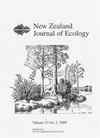城乡梯度凋落叶象鼻虫的遗传多样性和分化
IF 1.4
3区 环境科学与生态学
Q3 ECOLOGY
引用次数: 2
摘要
城市保护区具有保持较高生物多样性的潜力。然而,其中的类群种群可能会减少遗传多样性,如果种群之间的基因流动受到城市化环境的抑制,可能会出现遗传分化。本文研究了新西兰西奥克兰(Waitākere Ranges Regional Parkland)和郊区的不同城乡梯度上,不同地理位置的象甲Geochus politus凋落叶的群体遗传分化和多样性是否存在差异。在9个采样地点的300个个体中开发并筛选了9个微卫星标记。成对FST值、主坐标分析和人口结构的贝叶斯估计都表明,大多数城市站点与其他站点存在强烈的差异。这个位点的杂合度最低,FIS值最高,这可能表明遗传变异的丧失和更大程度的近交,尽管程度不是很大。在连续森林的采样地点之间也观察到差异,这表明城市化和其他景观变量正在影响这些地点之间的基因流动。这项研究强调了城市保护区容纳重要多样性的潜力,并强调了维护这些遗址的重要性。本文章由计算机程序翻译,如有差异,请以英文原文为准。
Genetic diversity and differentiation in the leaf litter weevil Geochus politus across an urban-rural gradient
Urban reserves have the potential to retain relatively high biodiversity. However, populations of the taxa within them can have reduced genetic diversity and, if gene flow between populations is inhibited by urbanised surroundings, can become genetically differentiated. Here we determine whether differences in population genetic differentiation and diversity can be observed in the leaf litter inhabiting weevil Geochus politus along the urban-rural gradient spanning Waitākere Ranges Regional Parkland and suburbs of West Auckland, New Zealand. Nine microsatellite markers were developed and screened across 300 individuals from nine sampling locations. Pairwise FST values, a principal coordinates analysis, and Bayesian estimates of population structure all demonstrated that the most urban site was strongly differentiated from the others. This site also had the lowest heterozygosity and highest FIS values, potentially indicating a loss of genetic variation and a greater degree of inbreeding, although not to a dramatic extent. Differentiation was also observed among sampling locations within continuous forest, suggesting that both urbanisation and other landscape variables are influencing gene flow between these locations. This study highlights the potential for urban reserves to harbour significant diversity and emphasises the importance of maintaining these sites.
求助全文
通过发布文献求助,成功后即可免费获取论文全文。
去求助
来源期刊

New Zealand Journal of Ecology
环境科学-生态学
CiteScore
3.00
自引率
12.50%
发文量
35
审稿时长
>36 weeks
期刊介绍:
The New Zealand Journal of Ecology is a biannual peer-reviewed journal publishing ecological research relevant to New Zealand/Aotearoa and the South Pacific. It has been published since 1952 (as a 1952 issue of New Zealand Science Review and as the Proceedings of the New Zealand Ecological Society until 1977). The Journal is published by the New Zealand Ecological Society (Inc.), and is covered by Current Contents/Agriculture, Biology and Environmental Science, GEOBASE, and Geo Abstracts.
 求助内容:
求助内容: 应助结果提醒方式:
应助结果提醒方式:


